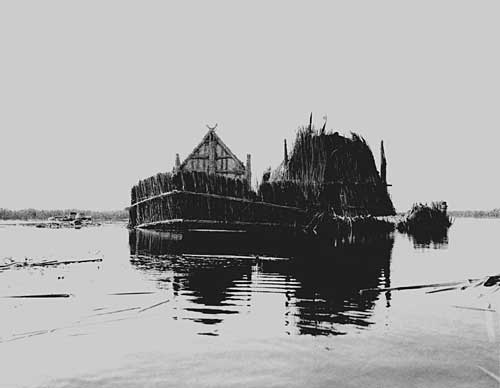Ursula Schulz-Dornburg
Across the territories
The German photographer Ursula Schulz-Dornburg (Berlin 1938) now lives in Düsseldorf. She became known internationally as a result of a series of exhibitions of her work in Europe and the USA. Across the territories is the first extensive presentation of her work to take place in Spain. The five series of photographs exhibited were made between 1980 and 2001. A selection of small-format photographs belongs to the context of a project in Armenia. Schulz-Dornburg’s photographs show archetypal places and situations: caves dug out of the mountainside in the Transcaucasus by hermits in the first Christian era; Armenian bus stops in the middle of nowhere, converted into a kind of strange architecture of waiting; weather stations on ice floes drifting in the middle of the Arctic, with an unreal quality because, when viewed more closely, they are seen to be photographs of dioramas; ancient island-houses built with reeds in the middle of the amphibious landscape of the Tigris delta, where there is only water, reeds, sky and horizon—a landscape that no longer exists; dark interiors in small chapels in the Pyrenees, the basic architectural form of which testifies to their Arab past, with narrow cracks through which light filters and picks out silent figures pacing out the passing of the days and seasons of the year. These are hushed situations, reduced to the essential, developed from a central space of emptiness and silence. Schulz-Dornburg’s work belongs to one of the main lines of modernity, presenting space as a dynamic and sometimes dramatic space. Landscapes and places are maintained in fragile equilibrium between birth and death; objects are seen in the light of their finite nature. In Schulz-Dornburg’s photographic narratives there is a layering of fragmented, linear, cyclic, interwoven structures. The space of the image comes into being on a borderline between internal and external landscape, between the real objects of the world and the perceiving consciousness. Precisely this area of transition gives rise to an insistent question, about how one can feel at home in a world where reference points are being diluted at a giddy pace, in a world where migrations and exile have become an established feature, a new, unparalleled form of nomadic existence. Haus (House or Home) and Wohnen (Dwelling) form the central theme of the meditation cave dug out by hermits in the Transcaucasus, just as they do in the chapel on the Camino de Santiago in the Pyrenees, in the floating reed house in the marshlands of the Tigris, the tent on an ice floe in the Arctic, or the bus stop nowhere in particular. Places and situations of transit marked by a dynamic created when different realities engage together.



